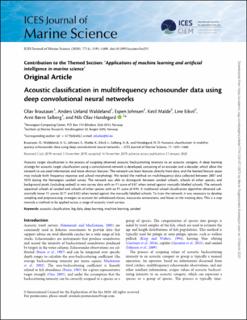| dc.contributor.author | Brautaset, Olav | |
| dc.contributor.author | Waldeland, Anders Ueland | |
| dc.contributor.author | Johnsen, Espen | |
| dc.contributor.author | Malde, Ketil | |
| dc.contributor.author | Eikvil, Line | |
| dc.contributor.author | Salberg, Arnt-Børre | |
| dc.contributor.author | Handegard, Nils Olav | |
| dc.date.accessioned | 2021-03-11T11:24:33Z | |
| dc.date.available | 2021-03-11T11:24:33Z | |
| dc.date.created | 2020-03-06T10:09:15Z | |
| dc.date.issued | 2020 | |
| dc.identifier.citation | ICES Journal of Marine Science. 2020, 77 (4), 1391-1400. | en_US |
| dc.identifier.issn | 1054-3139 | |
| dc.identifier.uri | https://hdl.handle.net/11250/2732849 | |
| dc.description.abstract | Acoustic target classification is the process of assigning observed acoustic backscattering intensity to an acoustic category. A deep learning strategy for acoustic target classification using a convolutional network is developed, consisting of an encoder and a decoder, which allow the network to use pixel information and more abstract features. The network can learn features directly from data, and the learned feature space may include both frequency response and school morphology. We tested the method on multifrequency data collected between 2007 and 2018 during the Norwegian sandeel survey. The network was able to distinguish between sandeel schools, schools of other species, and background pixels (including seabed) in new survey data with an F1 score of 0.87 when tested against manually labelled schools. The network separated schools of sandeel and schools of other species with an F1 score of 0.94. A traditional school classification algorithm obtained substantially lower F1 scores (0.77 and 0.82) when tested against the manually labelled schools. To train the network, it was necessary to develop sampling and preprocessing strategies to account for unbalanced classes, inaccurate annotations, and biases in the training data. This is a step towards a method to be applied across a range of acoustic trawl surveys. | |
| dc.language.iso | eng | en_US |
| dc.rights | Navngivelse-Ikkekommersiell-DelPåSammeVilkår 4.0 Internasjonal | * |
| dc.rights.uri | http://creativecommons.org/licenses/by-nc-sa/4.0/deed.no | * |
| dc.title | Acoustic classification in multifrequency echosounder data using deep convolutional neural networks | en_US |
| dc.type | Journal article | en_US |
| dc.type | Peer reviewed | en_US |
| dc.description.version | publishedVersion | |
| cristin.ispublished | true | |
| cristin.fulltext | original | |
| cristin.qualitycode | 1 | |
| dc.identifier.doi | 10.1093/icesjms/fsz235 | |
| dc.identifier.cristin | 1800050 | |
| dc.source.journal | ICES Journal of Marine Science | en_US |
| dc.source.volume | 77 | en_US |
| dc.source.issue | 4 | en_US |
| dc.source.pagenumber | 1391-1400 | en_US |
| dc.relation.project | Norges forskningsråd: 270966 | |

